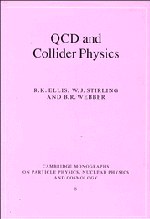Book contents
- Frontmatter
- Contents
- Preface
- 1 Fundamentals of QCD
- 2 Asymptotic freedom and confinement
- 3 QCD in electron-positron annihilation
- 4 Deep inelastic scattering
- 5 Parton branching and jet simulation
- 6 Jet properties beyond fixed order
- 7 Hadroproduction of jets and photons
- 8 Electroweak interactions
- 9 The production of vector bosons
- 10 Heavy quarks
- 11 Higgs bosons at high-energy colliders
- 12 Measurements of the strong coupling constant
- Index
10 - Heavy quarks
Published online by Cambridge University Press: 05 May 2010
- Frontmatter
- Contents
- Preface
- 1 Fundamentals of QCD
- 2 Asymptotic freedom and confinement
- 3 QCD in electron-positron annihilation
- 4 Deep inelastic scattering
- 5 Parton branching and jet simulation
- 6 Jet properties beyond fixed order
- 7 Hadroproduction of jets and photons
- 8 Electroweak interactions
- 9 The production of vector bosons
- 10 Heavy quarks
- 11 Higgs bosons at high-energy colliders
- 12 Measurements of the strong coupling constant
- Index
Summary
One of the motivations for collider experiments is to discover new heavy objects. It is therefore important to test our understanding of such processes by predicting the production rates for the known heavy objects, such as the top, bottom and charm quarks, and to compare the predictions with experimental measurements.
Aspects of the production of heavy quarks in e+e− annihilation have already been considered in Chapter 3. We shall concentrate here on the hadronic production of heavy quarks. An idea of the relative cross sections and signal-to-background ratios for c, b and t quark production at various present and future accelerators can be obtained from Table 10.1. As we shall see, the description of hadronic production is possible in perturbative QCD when the mass of the produced quark is large compared to 1 GeV, the typical scale of the strong interactions. Because the cross sections are generally large, hadronic interactions offer the potential to produce the large number of heavy quarks necessary to study their decays in detail. However, at present, much of the information on states containing c and b quarks comes from e+e− annihilation, because of the better signal-tobackground ratios at e+e− colliders.
As an illustration of the power of hadron colliders we consider the case of b production. For example, at the Fermilab Tevatron running at a luminosity of 2 × 1031 cm−2s-1, b quarks are produced at 400 Hz. This should be contrasted with an e+e− machine such as CESR operating at a luminosity of 2×1032 cm−2s−1, where the rate of 6 production is ∼ 0.1 Hz1.
- Type
- Chapter
- Information
- QCD and Collider Physics , pp. 332 - 387Publisher: Cambridge University PressPrint publication year: 1996



